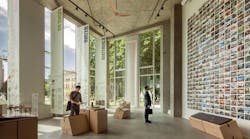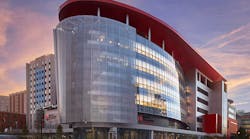In my November 2017 posting, I mentioned that Seattle's Bullitt Center then had already been net zero energy (NZE) for four years. In June of this year, after the landmark Unisphere in Silver Spring MD appeared on the cover of HPAC, billing itself as a "Net Zero First", loyal readers naturally asked me to compare the two buildings.
First of all, the Bullitt Center still bills itself as the “greenest commercial building in the world.” Tenants began moving into it in March 2013, and it was dedicated the following month, on Earth Day. The building is owned by the Bullitt Foundation, a philanthropic organization founded in 1952 by Dorothy Bullitt, who had brought television to Seattle in 1948. According to Foundation CEO Denis Hayes, “There is not a single urban office building in the United States that is truly designed for today’s environment, much less for tomorrow’s. So we set out to build one: the greenest urban office building in the world”. In addition to his leadership of the Bullitt Foundation and being the driving force behind the design and construction of the Bullitt Center, Hayes is best known as the primary national organizer of the first Earth Day in 1970 and, in 1977, as the author of Rays of Hope: The Transition to a Post-Petroleum World, one of the first books to address the threat posed by climate change and to suggest renewable energy as the solution.
The building itself is a 52,000 SF, six-story commercial office building, built to house variety of tenants, all of whom are required to commit to energy and water budgets as part of their lease. This ensures that the building will continue to meet the requirements of the Living Building Challenge (LBC), the green certification system selected in place of LEED. LBC is a rigorous performance-based certification that addresses the building-centric components found in LEED and Green Globes, such as site, energy water, and materials, but also includes elements related to beauty, equity, and health. In addition to utilizing an active and passive energy efficient design and solar PV to achieve NZE, the building has sustainable features that include a sophisticated building management system, a Walk Score of 99/100, rainwater harvesting, composting toilets, treated greywater for irrigation, and high efficiency mechanical equipment and systems.
By contrast, the 210,000-SF Unisphere was purpose built for United Therapeutics, a 23-year old biotechnology company, and its Lung Biotechnology PBC (public benefit corporation). It now claims to be the largest NZE building in the world. United Therapeutics was founded by Martine Rothblatt, the creator of Sirius Satellite Radio (now SiriusXM), in response to her daughter’s diagnosis of pulmonary arterial hypertension (PAH). PAH is a disease in which the blood pressure in the arteries of the lungs is high, which can in time permanently damage the heart. As a pharmaceutical company, United Therapeutics has focused primarily on drugs for the treatment of PAH.
Lung Biotechnology, the first PBC subsidiary of a publicly-traded biotech or pharma company, is also focused on PAH, but their approach is on solving the acute shortage of transplantable lungs, either by delaying the need for the lungs or by expanding the supply of transplantable lungs. Their approach is two-pronged: lung perfusion, developing ways to preserve and assess lungs for transplant, in order to increase the utilization rate of donated lungs; and Xenolung, the manufacture of transplantable lungs from genetically-engineered pig lungs, that is intended to increase access to donated lung and to improve transplant outcomes.
The Unisphere, which opened a year ago, is an elliptical building, with 120,000 SF of office space, 89,000 SF of clinical operations and community space, and 10,000 SF of retail space. Like the Bullitt Center, the Unisphere achieved NZE through the use of solar PV and numerous active and passive energy-efficient design strategies. It also employed some other innovative energy efficiency strategies, including a subterranean natural ventilation system and geothermal energy storage wells. Unlike the Bullitt Center, the Unisphere initially opted for a minimum of LEED Silver certification and actually achieved LEED Platinum last February.
Both buildings should serve as an inspiration to owners, designers, and builders everywhere.
A regular contributor to HPAC Engineering and a member of its editorial advisory board, the author is a principal at Sustainable Performance Solutions LLC, a south Florida-based engineering firm focusing on energy and sustainability.








